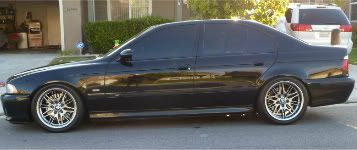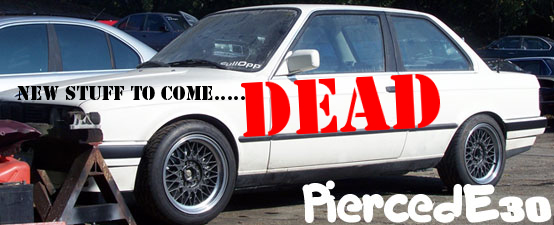I just finished smoking my non smile BOSCH European ellipsoids. The end result is exactly as HELLA does theirs, and for a fraction of the cost.
Here is a quick before and after of the same pair of ellipsoids (please don't mind the hard water spots on the outside of the lenses)
 -
-
Aside from basic tools you will need a can of black paint and some adhesive.
I used and recommend:
SEM trim black #39143
Automotive GOOP
Use this template (made from the genuine HELLA parts) to cut your high beam cross hairs:
Print these out at default size on cardstock. Don't scale or fit to page. Carefully and accurately cut them out for use later.
HELLA stamps these out of steel. You may use aluminum, or plastic if you must. I recommend you not use plastic as they sit very close to a bulb that does get fairly hot when in extended use. Thin sheets of steel/aluminum are readily available at most hardware stores.
HELLA paints their cross hairs and low beam shrouds with a satin paint which SEM #39143 matches perfectly.
LOW BEAM:
Start off by removing the low beam assembly from the bucket. There are 2 adjusters and one static peg. The small black cups that connect the adjuster rod to the low beam housing are fragile and with age hard. This makes them a serious pain to remove. I recommend replacing them at this time anyways so take them off however you find easiest. The part number for this little cup is 63 12 1 378 369.
After you have the low beam assembly removed from the bucket set it lense down and remove the projector. There are 3 Phillips screws at the base of the projector. Remove them and pull the projector out. Carefully remove the foam rubber seal under it as it will melt in the oven...
Pop the whole assembly in your oven. Shut the door and preheat to 350°F. Wait a little while after the preheated indicator comes on to let the part reach full temperature. Once you think it is up to temp go ahead and remove it with some gloves. Set it on a table and carefully start to push a wide flathead screwdriver between the lense and housing. Try several spots until you find a good one and start to pry up on it. Don't twist the screwdriver as you pry! This will put greatly more focused stress on the glass and can cause it to crack. Go slow and pry gently. It will lift up and come free if you are patient and careful.

Set the lense to the side and remove the projector shroud. It has little tabs that may still be glued in under where the lense sat. After you've removed the shroud you can prepare it for paint. Mine already had chrome that was missing. Its a cheap thin coating and easy to remove. Use some 0000 steel wool to scrub it and it will just wipe off. Make sure you get the sides of it too.

Wash it well with soap and water and let dry. Once dry find an appropriate place to paint it. SEM should be applied in 2 coats. The first coat should heavily mist the part but not have full coverage anywhere. Let this set for a minute or two then go back with a final coat. Don't fret if you get some trash in the paint on this part. You won't be able to see it once the lense is on anyways.
 -
-
While the shroud is drying clean the old adhesive from the housing. Use whatever works for you. I used a small flathead.
Once the shroud is dry put some adhesive on its mounting tabs and set it into place on the housing. Run a bead of adhesive all around the lense mounting face and set the lense in place. It also has tabs on the glass that locate it relative to the housing. Work the lense back and forth and wiggle it into place. Set this aside and let the adhesive dry. Give this a couple hours!
Once everything is dry reinstall it into the bucket with your new adjuster cups. Don't forget to snap the trim ring back on, which also needs to be painted with the SEM!
HIGH BEAM:
Start by removing the high beam assembly from the bucket. Same procedure as the low beam was. Remove the rear cap and bulb from the assembly as well and pop it in the oven. Preheat to 250°F if you have a metal high beam reflector, 350°F if you have plastic. In my case at 250°F with a metal housing I could take it out of the oven and just tap the back to make the lense fall right off. If yours does not do this carefully pry as with the low beam procedure.

Hopefully you have your high beam cross hairs already printed on card stock, transfered to the material you choose, and cutout accurately. If not.. go do that now.
Position your cross hairs in the high beam reflector. You can either set them up to look like a + or a x. This makes no difference to the end smoked look, but you can see the cross hairs so its an cosmetic thing. HELLA uses a + as did I.
I have to stress you need to use the final cross hairs, not the card stock ones which are prone to curvature. Position them where you want in the housing. Scribe marks where the tangs need to puncture the reflector and remove the cross hair. Go back with a dremel or whatever works for you and cut these little slots into the reflector. Plastic reflector guys go ahead and laugh at us metal guys...

You will likely need to fine tune the slots a tiny bit to get everything sitting perfectly.
Once everything lines up drop the cross hairs in and push the tangs through your slots. While making sure they are fully seated bend the tang over from the backside until the cross hairs are solid. Go ahead and apply a spot of sealant on the backside of the reflector where the tang is bent over to seal it.

Apply a bead of sealant all around the lense mounting face and slap the lense on... let dry, and reassemble!
Here is a quick before and after of the same pair of ellipsoids (please don't mind the hard water spots on the outside of the lenses)
 -
-
Aside from basic tools you will need a can of black paint and some adhesive.
I used and recommend:
SEM trim black #39143
Automotive GOOP
Use this template (made from the genuine HELLA parts) to cut your high beam cross hairs:
Print these out at default size on cardstock. Don't scale or fit to page. Carefully and accurately cut them out for use later.
HELLA stamps these out of steel. You may use aluminum, or plastic if you must. I recommend you not use plastic as they sit very close to a bulb that does get fairly hot when in extended use. Thin sheets of steel/aluminum are readily available at most hardware stores.
HELLA paints their cross hairs and low beam shrouds with a satin paint which SEM #39143 matches perfectly.
LOW BEAM:
Start off by removing the low beam assembly from the bucket. There are 2 adjusters and one static peg. The small black cups that connect the adjuster rod to the low beam housing are fragile and with age hard. This makes them a serious pain to remove. I recommend replacing them at this time anyways so take them off however you find easiest. The part number for this little cup is 63 12 1 378 369.
After you have the low beam assembly removed from the bucket set it lense down and remove the projector. There are 3 Phillips screws at the base of the projector. Remove them and pull the projector out. Carefully remove the foam rubber seal under it as it will melt in the oven...
Pop the whole assembly in your oven. Shut the door and preheat to 350°F. Wait a little while after the preheated indicator comes on to let the part reach full temperature. Once you think it is up to temp go ahead and remove it with some gloves. Set it on a table and carefully start to push a wide flathead screwdriver between the lense and housing. Try several spots until you find a good one and start to pry up on it. Don't twist the screwdriver as you pry! This will put greatly more focused stress on the glass and can cause it to crack. Go slow and pry gently. It will lift up and come free if you are patient and careful.

Set the lense to the side and remove the projector shroud. It has little tabs that may still be glued in under where the lense sat. After you've removed the shroud you can prepare it for paint. Mine already had chrome that was missing. Its a cheap thin coating and easy to remove. Use some 0000 steel wool to scrub it and it will just wipe off. Make sure you get the sides of it too.

Wash it well with soap and water and let dry. Once dry find an appropriate place to paint it. SEM should be applied in 2 coats. The first coat should heavily mist the part but not have full coverage anywhere. Let this set for a minute or two then go back with a final coat. Don't fret if you get some trash in the paint on this part. You won't be able to see it once the lense is on anyways.
 -
-
While the shroud is drying clean the old adhesive from the housing. Use whatever works for you. I used a small flathead.
Once the shroud is dry put some adhesive on its mounting tabs and set it into place on the housing. Run a bead of adhesive all around the lense mounting face and set the lense in place. It also has tabs on the glass that locate it relative to the housing. Work the lense back and forth and wiggle it into place. Set this aside and let the adhesive dry. Give this a couple hours!
Once everything is dry reinstall it into the bucket with your new adjuster cups. Don't forget to snap the trim ring back on, which also needs to be painted with the SEM!
HIGH BEAM:
Start by removing the high beam assembly from the bucket. Same procedure as the low beam was. Remove the rear cap and bulb from the assembly as well and pop it in the oven. Preheat to 250°F if you have a metal high beam reflector, 350°F if you have plastic. In my case at 250°F with a metal housing I could take it out of the oven and just tap the back to make the lense fall right off. If yours does not do this carefully pry as with the low beam procedure.

Hopefully you have your high beam cross hairs already printed on card stock, transfered to the material you choose, and cutout accurately. If not.. go do that now.
Position your cross hairs in the high beam reflector. You can either set them up to look like a + or a x. This makes no difference to the end smoked look, but you can see the cross hairs so its an cosmetic thing. HELLA uses a + as did I.
I have to stress you need to use the final cross hairs, not the card stock ones which are prone to curvature. Position them where you want in the housing. Scribe marks where the tangs need to puncture the reflector and remove the cross hair. Go back with a dremel or whatever works for you and cut these little slots into the reflector. Plastic reflector guys go ahead and laugh at us metal guys...

You will likely need to fine tune the slots a tiny bit to get everything sitting perfectly.
Once everything lines up drop the cross hairs in and push the tangs through your slots. While making sure they are fully seated bend the tang over from the backside until the cross hairs are solid. Go ahead and apply a spot of sealant on the backside of the reflector where the tang is bent over to seal it.

Apply a bead of sealant all around the lense mounting face and slap the lense on... let dry, and reassemble!








Comment